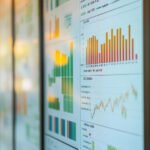Introduction: Data Dashboards Are a Type of Predictive Analytics
Zennemis – Data Dashboards Are a Type of Predictive Analytics. Did you know that about 90% of the information our brain gets is visual? This fact shows how important data visualization is in today’s business world. Data dashboards are key tools in predictive analytics, helping businesses make sense of complex data.
They show data in a way that’s easy to understand. This makes it simpler to make quick decisions. As more businesses rely on data, knowing how dashboards work is crucial.
Understanding Predictive Analytics
In today’s fast-paced world, knowing about predictive analytics is key for businesses to stay ahead. It uses different methods to look at current and past data. This helps users make better decisions and improve their outcomes.
What is Predictive Analytics?
Predictive analytics is a way to use data to make smart guesses about the future. It uses math and machine learning to find patterns in data. This helps businesses in many fields like finance, retail, and healthcare.
Importance of Predictive Analytics in Today’s Business Landscape
Predictive analytics is crucial for making decisions based on data. It helps businesses predict what customers will do and how the market will change. This leads to better performance and success.
Defining Data Dashboards
Data dashboards are key tools for companies to see and understand important performance signs. Knowing what a data dashboard definition is helps them use these tools better. This is important for keeping an eye on and improving business results.
What Are Data Dashboards?
A data dashboard shows important information in a clear way. It combines data from different sources into one place. This makes it easy for people to see how things are going and make quick decisions.
Key Features of Effective Data Dashboards
Good data dashboards are easy to use and can be changed to fit different needs. They also update data in real time. The dashboards should show dashboard KPIs in a way that’s easy to understand.
Being able to dig deeper into the data is also important. This lets users see more details behind the numbers. And, being able to use them on mobile devices means you can get important information anywhere.
Data Dashboards Are a Type of Predictive Analytics
Data dashboards are key tools for using predictive analytics. They combine predictive models to give insights into future performance. This makes it easier for organizations to understand trends and make better decisions.
Integrating Data Dashboards with Predictive Models
Data dashboards with predictive models let businesses see important metrics in real time. This helps with dashboard forecasting. Users can see current data and predictions from advanced algorithms.
This setup helps organizations make smart choices. It improves planning and makes operations more efficient. As data becomes more important, data dashboards play a bigger role. They show past and current data and help predict the future. This helps in making quick and smart decisions in a fast-changing market.
The Benefits of Using Data Dashboards for Predictive Analytics
Data dashboards are key tools for companies wanting to use predictive analytics. They offer many benefits that help improve performance and make operations smoother. By showing important metrics, businesses can use data to make smart choices.
Real-Time Data Insights
Data dashboards give real-time insights. Companies can watch trends and patterns as they happen. This lets teams react fast to market changes.
These quick data views help teams adjust strategies quickly. They use the latest information to make decisions.
Enhanced Decision Making
Data dashboards make decision-making better. They show complex data in a clear way. This makes it easy to see connections and understand data better.
With this clarity, teams can make strategic choices. These choices match the company’s goals.
Automated Reporting and Analysis
Another big plus of data dashboards is automated reporting. They can make reports on their own, saving time and cutting down on mistakes. This lets companies focus on understanding the data, not just collecting it.
How Data Dashboards Improve Forecasting Accuracy
Data dashboards are key in making forecasts more accurate across many industries. They use advanced data visualization for predictions. This turns complex data into insights that leaders can understand and use.
Data Visualization Techniques for Better Predictions
Using the right data visualization can make data easier to understand. Tools like heat maps, trend lines, and interactive graphs help spot patterns. These tools help use past data for better predictions.
By making data easier to see, businesses can plan better. They can use what they’ve learned from the past to make smarter choices.
Examples of Accurate Forecasting through Data Dashboards
Many companies have seen big improvements in forecasting thanks to dashboards. For example, big retailers use real-world dashboard examples to manage their stock better. They look at sales trends to guess what products will sell well.
This helps keep the right amount of stock and makes customers happier. In finance, dashboards help analyze market trends in real-time. This helps make investment decisions faster and more accurate.
Challenges in Implementing Data Dashboards
Setting up data dashboards comes with many challenges. These hurdles can make them less effective. It’s important to understand the problems with data quality and user engagement.
Data Quality Issues
Good data quality is key for making smart decisions with dashboards. Bad data can lead to wrong insights and wasted time. Companies need strong rules to check and clean data before it’s used.
Any mistakes in data quality can make the dashboard unreliable.
User Adoption and Training
Getting people to use dashboards can be tough. If users don’t get the training they need, they might not use them. It’s crucial for companies to offer good training.
With the right training, users will feel ready to use dashboards. This helps create a culture that values data-driven decisions.
Future Trends in Data Dashboards and Predictive Analytics
The world of data dashboards is changing fast. New technologies and a need for better analytics are driving this change. Businesses are using advanced tools to get valuable insights from their data.
Artificial Intelligence and Machine Learning in Dashboards
AI is changing how companies look at data. It helps dashboards predict future trends by studying past data. AI can quickly go through huge amounts of data, finding patterns that people might miss.
This means dashboards will soon be even smarter. They will help users make decisions based on up-to-date information.
Customizable Dashboards for Diverse Business Needs
There’s a growing trend towards dashboards that can be customized. Companies need dashboards that show what’s important to them. Customizable dashboards let users pick the metrics and data they need.
This makes dashboards more useful and engaging. It’s key for businesses to stay ahead by using these customizable features.
Conclusion: Data Dashboards Are a Type of Predictive Analytics
Data dashboards play a key role in predictive analytics. They help organizations see complex data clearly. This makes it easier to make quick, smart decisions in today’s fast world.
By combining predictive analytics with data dashboards, companies can improve their forecasting. This is crucial for staying ahead in business.
Data dashboards offer many benefits, like real-time insights and automated reports. They are essential for making strategic decisions. It’s important to focus on data quality, user adoption, and new technology trends.
Looking ahead, businesses must adapt to new technologies to succeed. Using effective dashboards will help make better decisions. It will also lead to growth in different industries.
FAQ: Data Dashboards Are a Type of Predictive Analytics
What is the definition of predictive analytics?
Predictive analytics uses data and algorithms to forecast future events. It helps businesses make better decisions by analyzing past data.
Why are data dashboards essential in today’s business landscape?
Data dashboards are key because they help understand complex data quickly. They provide insights for strategic decisions using real-time and historical data.
What are the key features of effective data dashboards?
Good data dashboards offer real-time data and customizable visuals. They integrate with various data sources and are easy to use. They also show important KPIs that match business goals.
How do data dashboards integrate with predictive models?
Data dashboards can show forecasted trends alongside current data. This helps in making better decisions by comparing past and future data.
What benefits do data dashboards provide for predictive analytics?
Data dashboards for predictive analytics offer many advantages. They provide real-time insights and help in making better decisions. They also automate reporting, saving time and boosting efficiency.
How do data visualization techniques improve forecasting accuracy?
Techniques like heat maps and trend lines make complex data easier to understand. This leads to more accurate predictions and useful insights.
What challenges might organizations face when implementing data dashboards?
Challenges include data quality issues and user adoption hurdles. Proper training is also crucial for effective use of data dashboards.
What future trends can we expect in data dashboards and predictive analytics?
Future trends will include more AI and machine learning in data analysis. Dashboards will also be more customizable, meeting diverse business needs and improving user experience.




